|
1964 Chevelle Super Sport
1964 was the first year for the Chevelle and the production number of Super Sports totaled 76,860 units. The standard engine for the Chevelle SS was a 120hp, 194ci six cylinder. An optional 155hp, 230ci six cylinder was also available. 9,775 Chevelles were equipped with one of these engines. A
195hp, 283ci engine was the base engine for V8 models. In December 1963, two additional engines were added to the options list, the 250hp 327 (RPO L30) and the 300hp 327 (RPO L74).
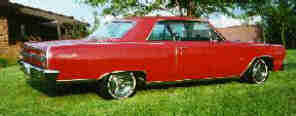
There were 67,085 Chevelle SS's built with V8 engines. Rear end gears of 3:08:1 were standard equipment. 1964 was the only year that a big block V8 was not offered on the Chevelle SS. The Muncie four speed manual transmission (M20) made its debut. SS insignia was located on the rear fenders, trunk lid, door panels and glove box door. All Super Sport Chevelles included: vinyl bucket seats, deluxe steering wheel, center console with floor shift (available with four speed or powerglide transmission) and gauges. The Greatest Musclecar of the earth was bom!
1965 Chevelle Super Sport
The 1965 Chevelle was re-designed giving the car a longer, sleeker appearance. A new front bumper and grill complimented the slightly re-designed rear. The interior of the 1965 Chevelle SS featured vinyl bucket seats (standard) and a center console if the four speed or the Powergide transmission was ordered. SS identification was attached to the glove box door. Standard SS identification consisted of SS emblems on the rear fenders and trunk lid, rocker panel moldings, a black accented grill and a black band around the taillights and rear cove panel.
The Z 1 6 option was introduced mid-year. This option centered around a new 375hp 396 engine.In addition to the usual SS identification, 396 Turbo-Jet crossflags were added to the front fenders and trunk lid.
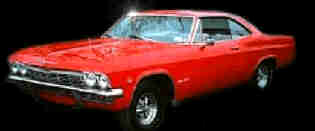 An SS 396 emblem was mounted on the right side of the dash. Z16 equipped Chevelles got 7.75 x 14" gold stripe Firestone tires mounted on 14" rims with mag style wheel covers. The interior featured a 160 mph speedometer, 6000 rpm tach and accessory clock. An AM /FM stereo radio with four speakers came standard with this option. The Z 1 6 option was priced at $1501.05 , which probably accounts for the fact that only 201 such equipped Chevelles were built. (200 coupes and I convertible). A 350hp 327 ci V8 (L79) was introduced. This engine was only available with a four speed transmission. This engine featured chrome valve covers and a dual snorkel air cleaner. A total of 6,021 Chevelles were produced with this engine. The big block 396 (RAT) motor in this car sent the Mustangs back to the corrals!
An SS 396 emblem was mounted on the right side of the dash. Z16 equipped Chevelles got 7.75 x 14" gold stripe Firestone tires mounted on 14" rims with mag style wheel covers. The interior featured a 160 mph speedometer, 6000 rpm tach and accessory clock. An AM /FM stereo radio with four speakers came standard with this option. The Z 1 6 option was priced at $1501.05 , which probably accounts for the fact that only 201 such equipped Chevelles were built. (200 coupes and I convertible). A 350hp 327 ci V8 (L79) was introduced. This engine was only available with a four speed transmission. This engine featured chrome valve covers and a dual snorkel air cleaner. A total of 6,021 Chevelles were produced with this engine. The big block 396 (RAT) motor in this car sent the Mustangs back to the corrals!
1966 Chevelle Super Sport
The 1966 Chevelle was a total new design. The car was made a little longer and a bit wider with better suspension handling. Six cylinders and small block V8's were no longer available in SS Chevelles. Buyers had to choose between three versions of the 396. The 325hp 396 was standard, while the 360hp and the 375hp were optional powerplants. For the first time, bucket seats and
console were no longer standard equipment. Bucket seats could be ordered under RPO A52 and center console with clock was RPO D55. Head rests (RPO A8 1) were also available.
The twin bulge SS hood made it's first appearance in 1966. Wheel opening trim and lower body side moulding were standard equipment in 1966 for the Chevelle SS. SS identification was in the fon-n of "Super Sport" script on the rear quarter panels, an SS
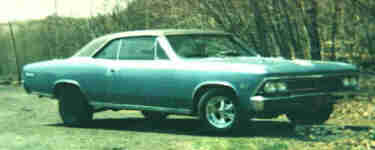 396 badge in the grill and rear cove panel, and 396 Turbo-Jet crossflags on the front fenders. Three styles of wheel covers were available on the SS 396 Chevelle in 1966. The "Dog Dish" style wheel cover was standard equipment. The simulated mag wheel (RPO N96) and the simulated wire wheel (RPO P02) were options. The open element air cleaner was new for 1966 and became standard SS 396 equipment. Only twelve M22 "Rockerusher" four speed manual transmissions were installed in SS Chevelles in 1966.
396 badge in the grill and rear cove panel, and 396 Turbo-Jet crossflags on the front fenders. Three styles of wheel covers were available on the SS 396 Chevelle in 1966. The "Dog Dish" style wheel cover was standard equipment. The simulated mag wheel (RPO N96) and the simulated wire wheel (RPO P02) were options. The open element air cleaner was new for 1966 and became standard SS 396 equipment. Only twelve M22 "Rockerusher" four speed manual transmissions were installed in SS Chevelles in 1966.
The rear cove panel was painted the same color as the body. Early sales brochures showed this area painted black, and a few early cars were produced that way. The blacked out rear cove panel became a feature for all SS 396's starting in 1967 and continued through 1970. Production for the 1966 Chevelle SS was 72,272 units. Since Ford never had a car that would run with the Chevelle in 1966, competition was limited to GTO's and Mopars.
1967 Chevelle Super Sport
New for 1967 SS 396 Chevelles were power front disc brakes. Option (RPO J52) included I I discs and Bendix four piston calipers. F70 x 14 wide oval tires were included with the SS 396 when optional L34 and L78 engines were ordered. The three speed turbo-hydromatic transmission (RPO M40) was now available as an option in SS 396 Chevell-es and El Carninos equipped with a big block. 1967 was the first year for an "SS" steering wheel in SS 396 Chevelles. The tachometer was moved to the upper left comer of the dash. It blocked the view of the gas gauge and left turn signal indicator. The turn signal indicator was added to the face of the tachometer.
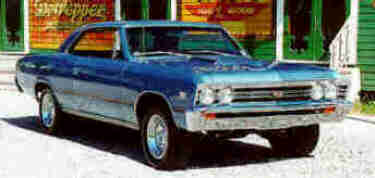
A blacked out rear cove panel became standard on SS 396 Chevelles. Twin "hood bulges" with non-functional grills were carried over from the 1966 model. Chevrolet did not build an SS El Camino in 1967, but it could be ordered with every option including a big block, without the "SS" emblems. SS 396 production dipped to 63,006 units for 1967. Only 612 Chevelles were ordered with the L78 SS 396 (375hp), and were listed as a dealer installed option. Even though the production number is lowered in the SS models, the 1967 Malibu had extremely high production numbers. Viffile the 1967 SS Chevelle may be hard to find these Malibu's can be found everywhere and are becoming more popular everyday.
1968 Chevelle Super Sport
The Chevelle received a major re-design in 1968, giving it more of a fastback look. 1968 was the only year that an SS 396 El Camino was offered as a specific individual model. In 1968 the Chevelle chassis came in two wheel bases: one for two door models, another for four-doors, wagons and El Caminos. Before 1968, all Chevelles measued 115" from hub to hub. For 1968, two doors measured 112" while the rest of the line got a longer 116" chassis. Beginning in 1968 the VIN plate was located on the dash and visible through the windshield. Engine choice was unchanged from 1967, limited to three 396 engines.
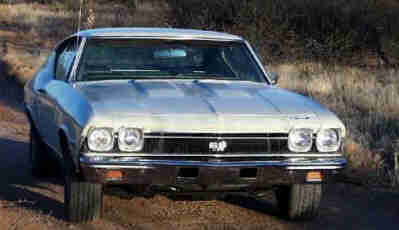
The 1968 Chevelle SS 396's got improved finned front brake drums. Optional front disc brakes were available with the rally rims. 1968 was the first year for hideaway windshield wipers and they were standard on SS 396 models. The 375hp SS 396 option finally made it's way to the front side of the order sheet. 4,751 Chevelles were ordered with this option. The turbo jet crossflags were replaced by a tag incorporated into the front side marker
lamp bezels. Early cars included the SS with the numerals 396.
From 1968 on, all engines used a spin on oil filter rather than the canister style with replacement cartridge. One way to tell a 1968 SS 396 from the run of the mill Chevelle was it's exclusive lower body treatment. All but dark colored Super Sports got a blacked out section below the lower body side trim. Adding the optional pinstripes (RPO D96) deleted that treatment, although early models came with both. Production of the SS 396 Chevelles dipped slightly from 1967, to 57,595 units, along with 5,190 SS 396 El Caminos. Even though the production numbers jumped back up in 1968, today it is one of the harder to find years of SS Chevelles.
1969 Chevelle Super Sport
New for 1969 was the L89 aluminum head option for the 375hp SS 396. Since this option was only available with the L78 option, it added an extra $647.75 on top of the standard SS 396 package. 400 such combinations were built in 1969. The SS 396 option became available on the 300 Deluxe Sport Coupe and the 300 Deluxe Sedan. Although no production figures are available, the 1969 SS 396 300 Post Sedan is very rare. This was the only year that the SS396 option was available on the 300 series. The 1969 Chevelle SS was no longer a separate model series. It became RPO Z25. It was the first year for the five spoke magnum wheel with SS center cap as standard equipment.
During the model year,,the 396's bore was increased from 4.094" to 4.125" resulting in 402 cid. However the engine was still marketed as the SS 396 in 1969 and subsequent years. The Powerglide two speed automatic transmission was no longer available.
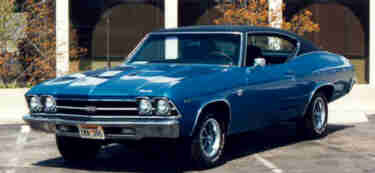 It was the first year for the now legendary F41 sport suspension (RPO F41) and the chambered dual exhaust (RPO NC8). Wiper arms on the 300 Deluxe SS 396 did not retract beneath the edge of the twin bulge super sport hood, as on the Malibu models. "Wing" vent windows were included on this model, although deleted in 1968 on Malibu's.
It was the first year for the now legendary F41 sport suspension (RPO F41) and the chambered dual exhaust (RPO NC8). Wiper arms on the 300 Deluxe SS 396 did not retract beneath the edge of the twin bulge super sport hood, as on the Malibu models. "Wing" vent windows were included on this model, although deleted in 1968 on Malibu's.
The M22 "rock crusher" 4 speed transmission was only available with the L78 option. Rear end gear ratios ranged from 3:07:1 to as low as 4:88: 1. It is estimated that as many as 323 COPO 427 Chevelles were built, with at least 99 of them going to Yenko Chevrolet in Canonsburg Pennsylvania. SS 396 production reached it peak in 1969, numbering 86,307 units for both Chevelle and ElCarnino combined. So remember, if you ever see a 1969 Chevelle Station Wagon that is an SS, it may very well be a REAL SUPER SPORT!
1970 Chevelle Super Sport
1970 Chevelle was refined from head to toe over the styling of the 1969 model. Although dispacing 402cid, Chevrolet continued to advertise the 1970 Chevelle Super Sport as a 396. To confuse things even more, a new big block engine was introduced. It was the LS3 rated at 330hp and labeled as a 400cid. This engine was available in all non SS cars. It was the first time that a big block was offered without super sport equipment. A new 400cid small block was also introduced. The legendary "cowl induction" hood option (RPO ZL2) was introduced for 1970, which could be ordered on the Chevelle SS and El Camino SS. The cowl induction hood was ordered 28,888 times.
The optional sport stripe kit (RPO D88), featured twin "band aid" stripes on the hood and
rear deck. These stripes were added automatically when the cowl induction hood was ordered. The External mounted antenna was eliminated, and replaced with a wire embedded in the windshield. Super Sport traditions like the "SS" logos, blacked out grill and cove panel carried over from 1969,
only in a different fashion. The grill and cove panel emblems were larger and more distinctive and did away with engine identification.
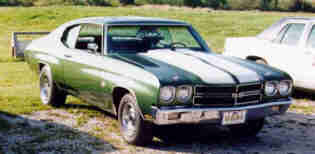 The SS 396 fender badges remained, along with a new SS 454 fender badge. 1970 Chevelle Super Sports had clear rather than amber front turn signal lamps. An aggressive single domed hood replaced the twin bulges on Chevelle SS models. The SS 454 option was added for 1970. It came in two versions: the standard LS5 454cid rated at 360hp
(4,298 made),
and the optional LS6 version rated at a whopping 450hp!
(3,773 made),
Production for SS 454 Chevelles numbered 8,773 of which 4,475 were of the LS6 variety. These 1970 Chevelles are becoming some of the more rare Chevelles these days.
The SS 396 fender badges remained, along with a new SS 454 fender badge. 1970 Chevelle Super Sports had clear rather than amber front turn signal lamps. An aggressive single domed hood replaced the twin bulges on Chevelle SS models. The SS 454 option was added for 1970. It came in two versions: the standard LS5 454cid rated at 360hp
(4,298 made),
and the optional LS6 version rated at a whopping 450hp!
(3,773 made),
Production for SS 454 Chevelles numbered 8,773 of which 4,475 were of the LS6 variety. These 1970 Chevelles are becoming some of the more rare Chevelles these days.
1971 Chevelle Super Sport
Chevelle SS production dropped to a record low of 19,293 units. The "Heavy Chevy" was introduced as a budget minded Super Sport, with sales of 6,727 it's first year. The blacked out grill was carried over on the Chevelle SS's, although the blacked out rear pad treatment was discontinued. With the exception of the front grill, turn lamps, headlight bezels, and the rear bumper,
the remaining sheet metal was unchanged from 1970. Unless the 454 option was ordered, a plain "SS" badge was displayed on the front fenders. Both the 402 and the 454 big blocks were offered under RPO Z 1 5. Standard equipment for the SS Chevelles were IS " rims and F60 tires. 1971 Chevelles featured single 7" headlights instead of the dual units used in previous years.
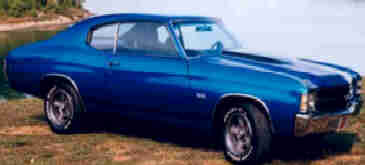
For the first time since 1965, a small block V8 could be ordered in a Chevelle SS. There were two versions available, both 350 cubic inches. They were the 270hp (RPO L48) and the 245hp (RPO L65). Both the cowl induction hood (RPO ZL2) and the "band aid" sports stripes (RPO D85) were carried over from 1970. The cowl induction hood was to be limited to big block cars. It is rumored that some dealers installed this option on small block cars. Production records indicate that fourteen LS6 454 engines were built, but were never installed in any car available to the public.
1972 Chevelle Super Sport
Super Sport Chevelle production for 1972 was 24,946. Of these, 5,333 were of the SS 454 variety. Production of the "Heavy Chevy" model (RPO YF3) totaled 9,508 units. The exterior of the 1972 Chevelle SS was nearly identical to the 1971 version. Minor changes included restyled side front marker lights and a totally blacked out grill. The domed hood
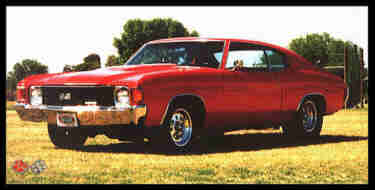 now featured locking pins. The 402 and the 454 big blocks were available again as RPO Z 1 5. Available for the first time in a Chevelle SS, was the Turbo Fire 3 07 small block, rated at 130hp. For the first time since 1968, the two speed Powerglide transmission was available. The F-41 suspension remained as part of the Z 1 5 option as well as front disc brakes. 1972 ended the Chevelle saga. There were a few so-called Chevelles in 1973, 1974, and 1975 but these were only glorified Malibu's.
now featured locking pins. The 402 and the 454 big blocks were available again as RPO Z 1 5. Available for the first time in a Chevelle SS, was the Turbo Fire 3 07 small block, rated at 130hp. For the first time since 1968, the two speed Powerglide transmission was available. The F-41 suspension remained as part of the Z 1 5 option as well as front disc brakes. 1972 ended the Chevelle saga. There were a few so-called Chevelles in 1973, 1974, and 1975 but these were only glorified Malibu's.
|









